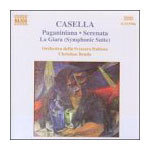
Paganiniana / Serenata / La Giara
 $25.00
Out of Stock
$25.00
Out of Stock6+ weeks add to cart
CASELLA
Paganiniana / Serenata / La Giara
Radio Svizzera Italiana Orchestra; Christian Benda, conductor
[ Naxos / CD ]
Release Date: Tuesday 6 January 2004
This item is currently out of stock. It may take 6 or more weeks to obtain from when you place your order as this is a specialist product.
"The performances are as delightful as the music"
- David Hurwitz, Classicstoday.com
Born into a musical family in Turin, Alfredo Casella showed early ability as a pianist. His father, like his two uncles, paternal grandfather and godfather, Alfredo Piatti, was distinguished as a cellist, but it was from his mother that he had his early piano lessons. At the age of twelve, on the advice of the composer, pianist and conductor Giuseppe Martucci, director of the Liceo Musicale in Bologna and a family friend, and of the old violinist Antonio Bazzini, director of the Milan Conservatory, it was decided that he should study at the Paris Conservatoire. With the death of his father in 1896, after some years of illness, he and his mother moved to Paris, where, in November, he began his studies. There, in 1901-1902, he attended the composition class of Gabriel Fauré, while from the beginning he had studied the piano with Louis Diemer and harmony with Xavier Leroux. He remained in Paris for some nineteen years, associating with Ravel and with the Romanian George Enescu, admiring Debussy and the Russian Stravinsky, but above all at first influenced by Mahler and Richard Strauss, and by performances of Wagner he had first heard in Turin under Toscanini. After leaving the Conservatoire in 1902 he embarked on a career as a pianist and harpsichordist, primarily working in chamber music and as an accompanist. It was at this period that he wrote his first two symphonies. In 1911 he embarked on an intended series of popular symphony concerts at the Trocadero, conducting, as he had done intermittently over previous years, but the series had to be abandoned after the first five concerts. The general artistic atmosphere of Paris had its influence on him and the weightier influence of Mahler and Strauss was replaced by that of composers such as Stravinsky and Albeniz, all of which suggests a certain eclecticism.
Casella 's career in Paris reached a height of contemporary distinction with the 1914 performance of his song-cycle Nolle di Maggio, a setting for low voice and orchestra of poems by Giosue Carducci, a scholar and writer who had devoted his attention to a patriotic revival of interest in the Italian past. The work had a mixed reception. By 1915 Casella had realised that his future lay in Italy. In that year he settled in Rome, teaching the piano at the Liceo Musicale di Sta Cecilia until 1923 and thereafter, during the following decade, responsible for a master-class at the Liceo. It was here that he found himself a figure of importance in a circle of young Italian musicians who shared his ambition to bring a country that generally seemed musically provincial and backward into the mainstream of the European music with which he had been familiar in Paris.
In 1917 Casella established the Societa Nazionale di Musica, which later became the Societa ltaliana di Musica Moderna and then, in 1923, he set up, with rather different aims, the Corporazione delle Nuove Musiche, affiliated to the International Society for Contemporary Music, which had been founded in Salzburg in 1922. In the earlier society various composers found a place, including Respighi, Malipiero, Pizzetti, Castelnuovo-Tedesco, the conductor and composer Vittorio Gui and Puccini's generally acknowledged successor Riccardo Zandonai. The Corporazione, however, aimed to introduce a wide international spectrum of contemporary music to Italian audiences. The new organization, which continued for the next five years, was established in conjunction with Malipiero and with the strong moral backing of Gabriele d'Annunzio and soon the very practical financial support of Elizabeth Sprague Coolidge. The composers in the earlier society, which, over three years, had served its own limited purpose, were obviously divergent in their styles and aims and there were serious divisions, when, subsequently, more conservative composers such as Respighi, Pizzetti and Zandonai attacked the progressive tendencies of the 1930s, which continued in spite of this and in spite of the banning of Italy from the ISCM in 1939. Casella, however, remained a leading figure in the crusade to bring to the Italian public a wider awareness of contemporary musical trends abroad, something he was able in part to achieve by his own work as a concert pianist and as a conductor.
Tracks:
Paganiniana: Divertimento for Orchestra, Op. 65
Serenata for Chamber Orchestra, Op. 46bis
La Giara, Op. 41bis, Suite sinfonica

